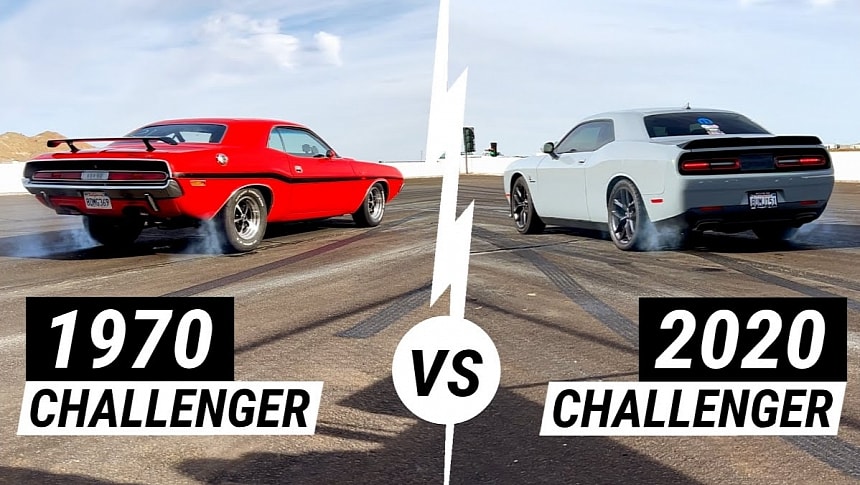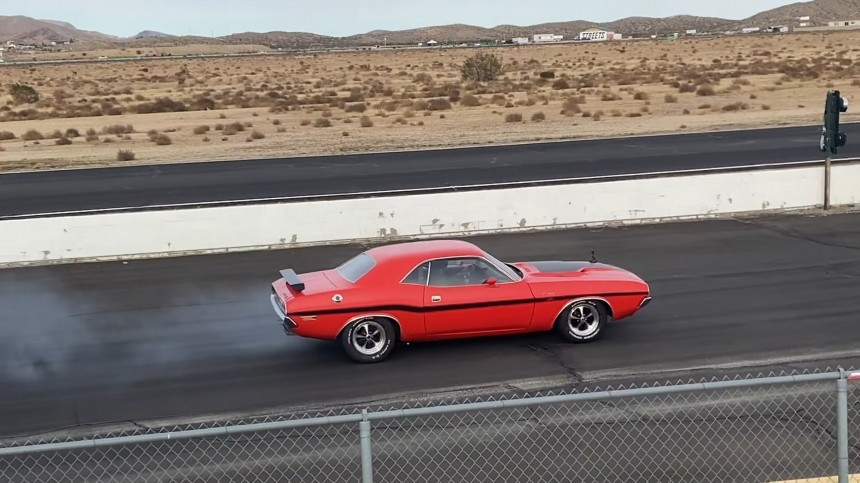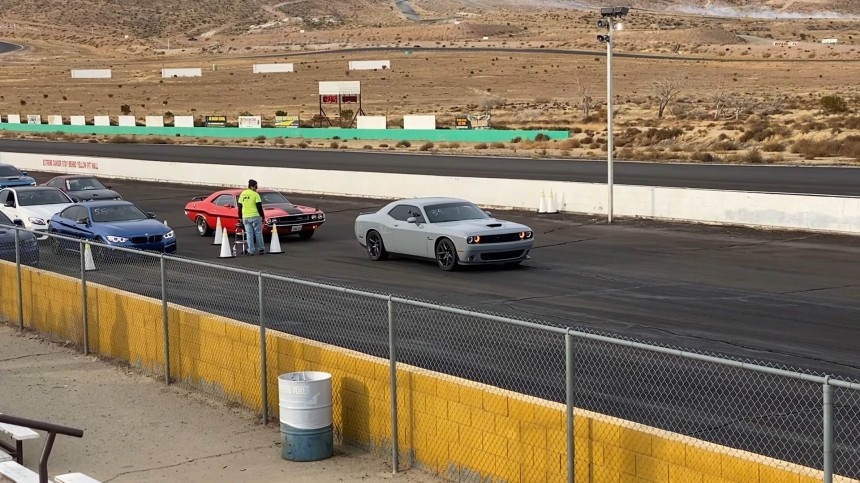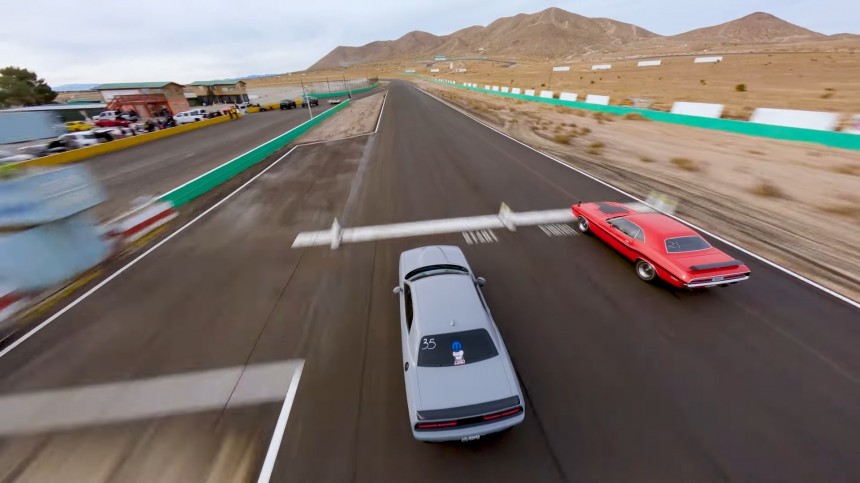The Challenger is one of Dodge’s most fabled nameplates (right behind the Charger), and the model's first generation is quite undeniably the star of its Mopar bloodline. That’s not to say that the second generation of the fabled pony car isn’t a show-stopper in its own right, but it just doesn’t rise to the glory of its forefather. So imagine what comes out of a family reunion that sees a 1970 and a 2020 raising their Hemis in honor of the almighty quarter-mile.
The first standalone Dodge Challenger model appeared late in the pony car field, launched on September 25, 1969, as a 1970 model. It was seconded by its twin cousin from Plymouth, the Barracuda, with which it shared the E-body platform but no sheet metal.
The rationale behind the reconfigured Mopar pony was to give it the ability to accommodate every single powerplant available in Chrysler's arsenal, from the measly 198 cubic-inch inline six-cylinder (3.2 liters) all the way to the hunky 426 Hemi ‘Elephant.’
The Challenger didn’t come with the smallest Slant Six that could be had in the Barracuda, instead opening the motor offerings with a 225-cube ‘leaning tower of power’ (3.7 liters). All in all, nine engine versions in six displacements were available. For comparison, in 2020, Dodge offered just five powerplants (in four sizes). That’s a point for the old-timer, and let’s make it two-nill with the cubic-inch metric.
In the modern age of the Challenger, the standard engine was another six-cylinder, the 3.6-liter Pentastar V6 (slightly smaller than the half-century-older venerable Slant Six). In 1970, the biggest engine was the 440 big-inch V8, the 7.2-liter torque ogre. Come 2020, the largest biceps is the 6.4-liter V8 (the naturally aspirated 392 HEMI).
This is where things went sideways: the second-generation Challenger got four HEMI powerplants, while the inceptor of the seventies had just one – THE one. However, the young blood definitely outguns the classic with the 6.2-liter Hellcat, the mighty supercharged V8 that powered the 2018 Demon, among other street brawlers.
Four different HEMI engines came In the 2020 Challenger, from the 5.7-liter and the 392 to the two 6.2-liter force-fed Hellcats (the Redeye and the ‘regular’ variants – if ever there was such a thing as a regular Hellcat). Putting a 54-year-old Challenger to run against a four-year-fresh Challenger wouldn’t exactly be the most balanced of fights. However, the odds get closer to even through the magic of engine swapping.
So here they are, a 5.7 HEMI-swapped 1970 Challenger with a six-speed manual transmission and a limited-slip 4.10 rear axle gearing facing off a 5.7-liter 20202 Challenger with nitrous steroids, an eight-speed automatic, and 700 extra pounds.
The old-timer tips the scale at 3,500 lbs (1,588 kg), while the young gun weighs in at 4,200 lbs (1,905 kg). The first-generation Challenger was dyno’ed at 371 hp and 377 lb-ft (376 PS, 511 Nm) at the rear wheels. Theoretically, the second-gen pony Challenger challenger should put some 375 hp and 400 lb-ft at the crank (380 PS, 551 Nm). However, its original output is irrelevant with the 100 shot of nitrous.
What matters is the standing quarter result, and that’s a double KO from the modified primordial Dodge Challenger, which scores an 11.38-second sprint at 96 mph (154.5 kph), marginally quicker than the 11.73-second of the rival. The driver’s reaction times of .59 and .45, respectively, show that it wasn’t a human error that caused the newer car to come last.
The second-round results are no different, and there are only minor differences in the times (11.19 sec for the 1970 car and 11.35 sec for the third-millennium offspring, with trap speeds of 97 and 100 mph / 156 kph and 161 kph).
One final note: I am fully aware that the 2020 Challenger technically belongs to the third generation of the nameplate, but I won’t insult the moniker by including the badge-engineered Mitsubishi Galant Lambda from ’78-’83 in this pony car lineup of Mopar legends.
The rationale behind the reconfigured Mopar pony was to give it the ability to accommodate every single powerplant available in Chrysler's arsenal, from the measly 198 cubic-inch inline six-cylinder (3.2 liters) all the way to the hunky 426 Hemi ‘Elephant.’
The Challenger didn’t come with the smallest Slant Six that could be had in the Barracuda, instead opening the motor offerings with a 225-cube ‘leaning tower of power’ (3.7 liters). All in all, nine engine versions in six displacements were available. For comparison, in 2020, Dodge offered just five powerplants (in four sizes). That’s a point for the old-timer, and let’s make it two-nill with the cubic-inch metric.
This is where things went sideways: the second-generation Challenger got four HEMI powerplants, while the inceptor of the seventies had just one – THE one. However, the young blood definitely outguns the classic with the 6.2-liter Hellcat, the mighty supercharged V8 that powered the 2018 Demon, among other street brawlers.
Four different HEMI engines came In the 2020 Challenger, from the 5.7-liter and the 392 to the two 6.2-liter force-fed Hellcats (the Redeye and the ‘regular’ variants – if ever there was such a thing as a regular Hellcat). Putting a 54-year-old Challenger to run against a four-year-fresh Challenger wouldn’t exactly be the most balanced of fights. However, the odds get closer to even through the magic of engine swapping.
The old-timer tips the scale at 3,500 lbs (1,588 kg), while the young gun weighs in at 4,200 lbs (1,905 kg). The first-generation Challenger was dyno’ed at 371 hp and 377 lb-ft (376 PS, 511 Nm) at the rear wheels. Theoretically, the second-gen pony Challenger challenger should put some 375 hp and 400 lb-ft at the crank (380 PS, 551 Nm). However, its original output is irrelevant with the 100 shot of nitrous.
What matters is the standing quarter result, and that’s a double KO from the modified primordial Dodge Challenger, which scores an 11.38-second sprint at 96 mph (154.5 kph), marginally quicker than the 11.73-second of the rival. The driver’s reaction times of .59 and .45, respectively, show that it wasn’t a human error that caused the newer car to come last.
One final note: I am fully aware that the 2020 Challenger technically belongs to the third generation of the nameplate, but I won’t insult the moniker by including the badge-engineered Mitsubishi Galant Lambda from ’78-’83 in this pony car lineup of Mopar legends.






























